Looking for a one-of-a-kind experience in Vientiane, Laos? Then you won’t want to miss Buddha Park, a unique sprawling sculpture park that you have to see to believe.
After three years living in Vientiane, Buddha Park has become one of our top recommendations of places to visit.
Read on to discover why we think you should visit, plus all the essentials you’ll need for your day trip like how to get there, what to expect, and important locals’ tips for visiting.
Planning a Visit to Vientiane?
Be sure to bookmark these other helpful guides:
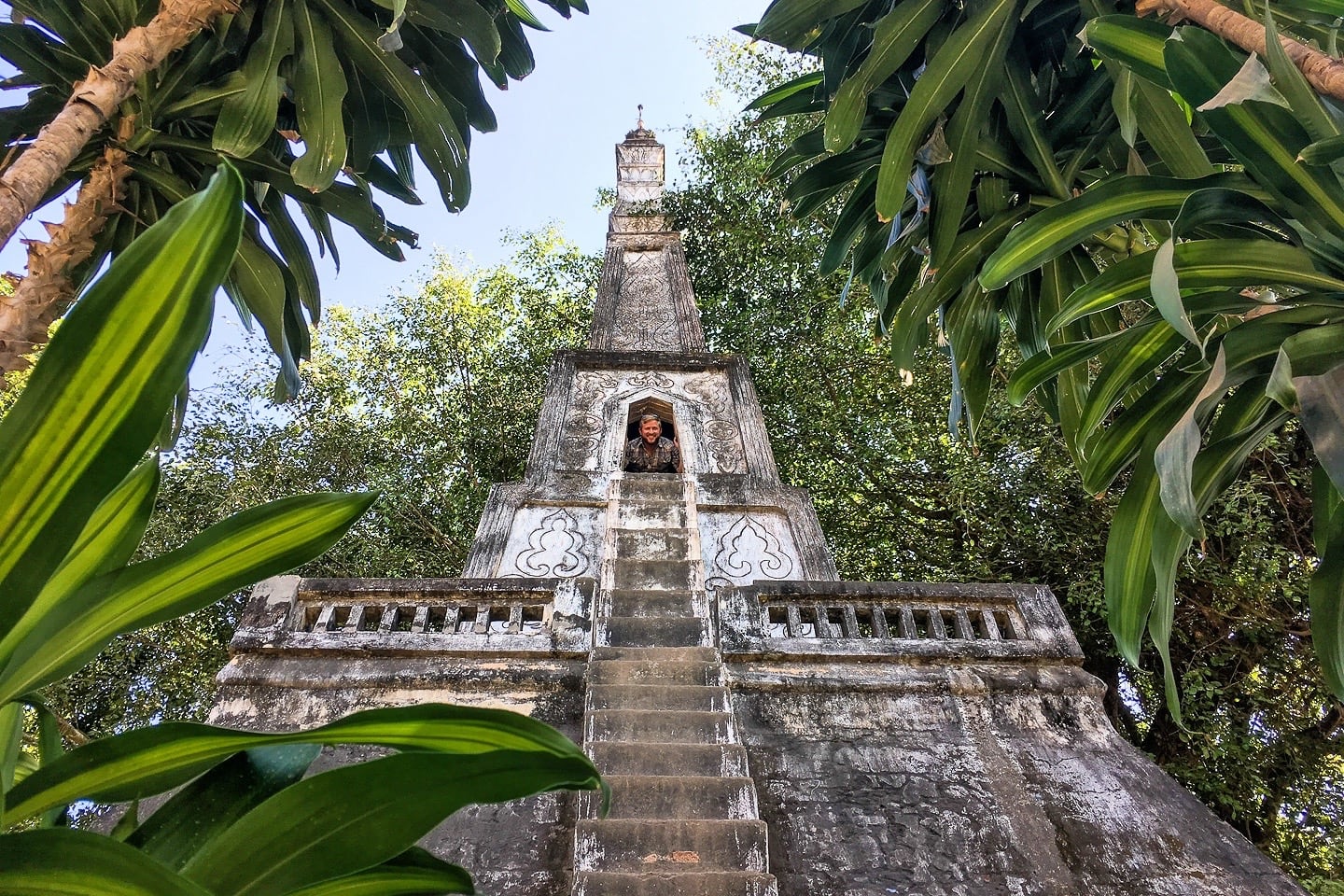
Buddha Park Quick Facts
| Location: | Dongphosy, Laos (40 minutes east of Vientiane) |
| GPS: | N17°54’45.223″ E102°45’53.182″ |
| Transport: | Bus #14 from Vientiane Central Terminal; Tuk-Tuk; Private Hire |
| Park Hours: | 8am – 5pm, Every Day |
| Entrance Fee: | Tourists: 40,000 LAK | Locals: 15,000 LAK (October 2023) |
| Dress Code: | Casual, but modest (no special requirements) |
| Food Onsite: | Restaurant & Snack Shacks |
| Exposure: | Shaded restaurant and other waiting areas, but otherwise hot and exposed. |
| Restrooms: | Modern Western facilities added in 2017. |
| Lodging: | No nearby tourist-class options. We recommend staying in Vientiane city. |
| Time Commitment: | 1-3 hours, depending on whether you get lunch at the restaurant. |
Why Visit Buddha Park
Buddha Park is located on the Mekong River 15 miles (25km) east of Vientiane city center and makes for an easy and worthwhile half-day trip.
Known locally as Xieng Khuan (literally meaning “Spirit City”), this quirky and unique site with a fascinating history is home to over 200 statues depicting Buddhist and Hindu figures.
Best of all, you can even climb up in and explore a couple of the structures, chief among these being the 2-story “Giant Pumpkin”.
In short, it’s one crazy place that you wouldn’t expect to find in Vientiane, or anywhere else, for that matter.
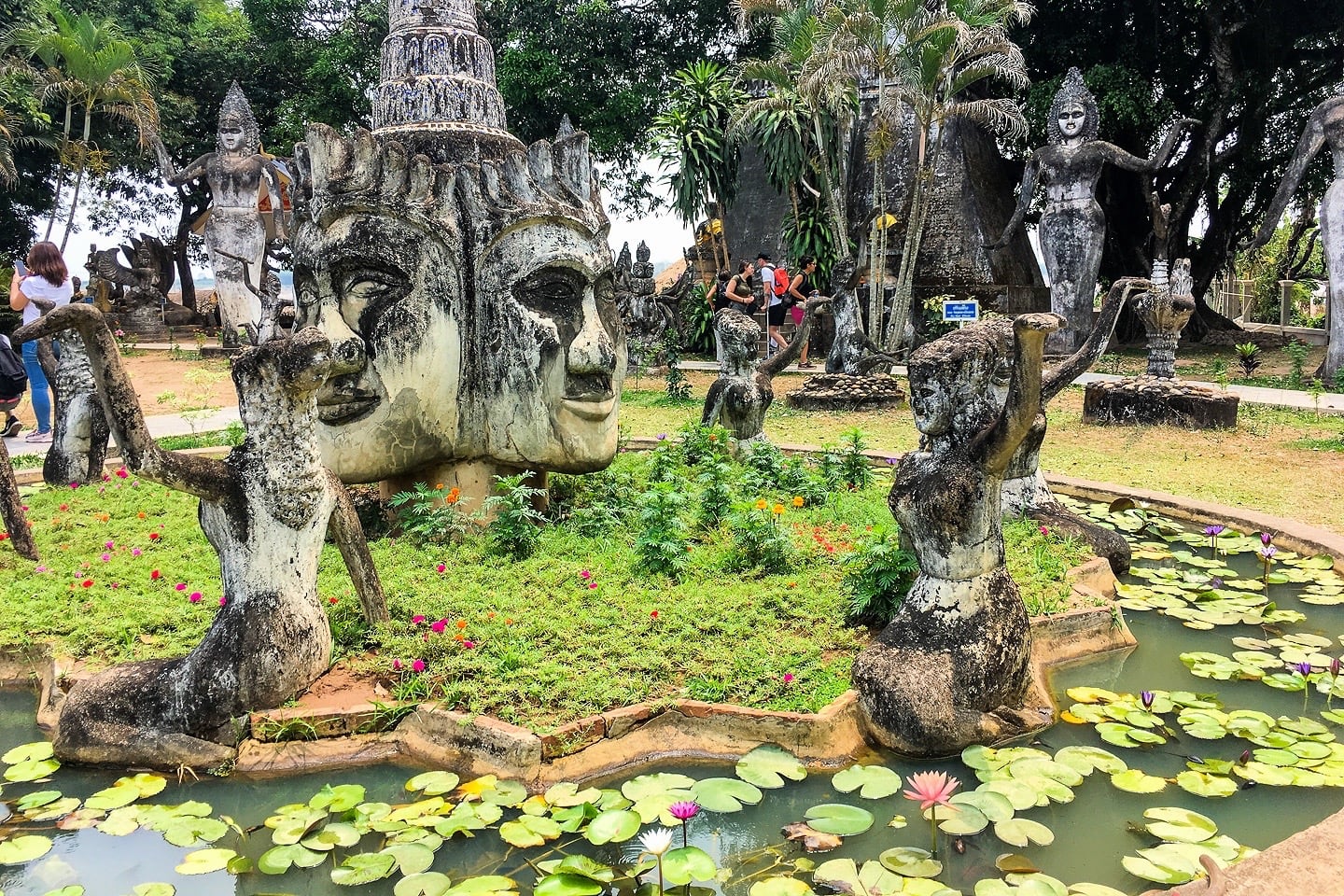
The Story of Buddha Park
At first glance, this place appears to be comprised of very old stone handiwork. In reality, most of the statues and sculptures were constructed of reinforced concrete beginning in 1958.
The sculptor behind the images is Bunleua Sulilat, whose unique Buddhist-Hindu perspective was largely shaped by a Hindu rishi (sage) who he studied under in Vietnam.
Sulilat’s story, as told at the Buddha Park visitor center, states that he met the rishi after falling into a cave when he was a child (you can choose which story to believe).
Buddha Park seems like a one-of-a-kind place, but there are actually TWO of these parks sculpted by Sulilat.
After the 1975 revolution in Laos, Sulilat fled across the river. Wishing to continue the work begun in Laos, he decided to build another park. The other Buddha Park—Sala Keoku—lies just over the Mekong in Nong Khai, Thailand.

How to Get from Vientiane to Buddha Park by Public Bus
Catch the #14 bus to Buddha Park at Central Bus Station (CBS) in Vientiane, across from Talat Sao “Morning Market”.
You’ll want to confirm your #14 bus goes all the way to Xieng Khuan/Buddha Park, as some of them only go as far as the Friendship Bridge/ Thai border.
In March 2024, the ride costs 18,000 LAK per person each way, takes between 45 and 60 minutes, and offers a pleasant journey with air conditioning and comfy seats.
If we had hired a tuk-tuk for the day to take us out there it would have cost around 10x more for the two of us, and is far less comfortable of a ride. Buses run all day long and depart about every 20 minutes.
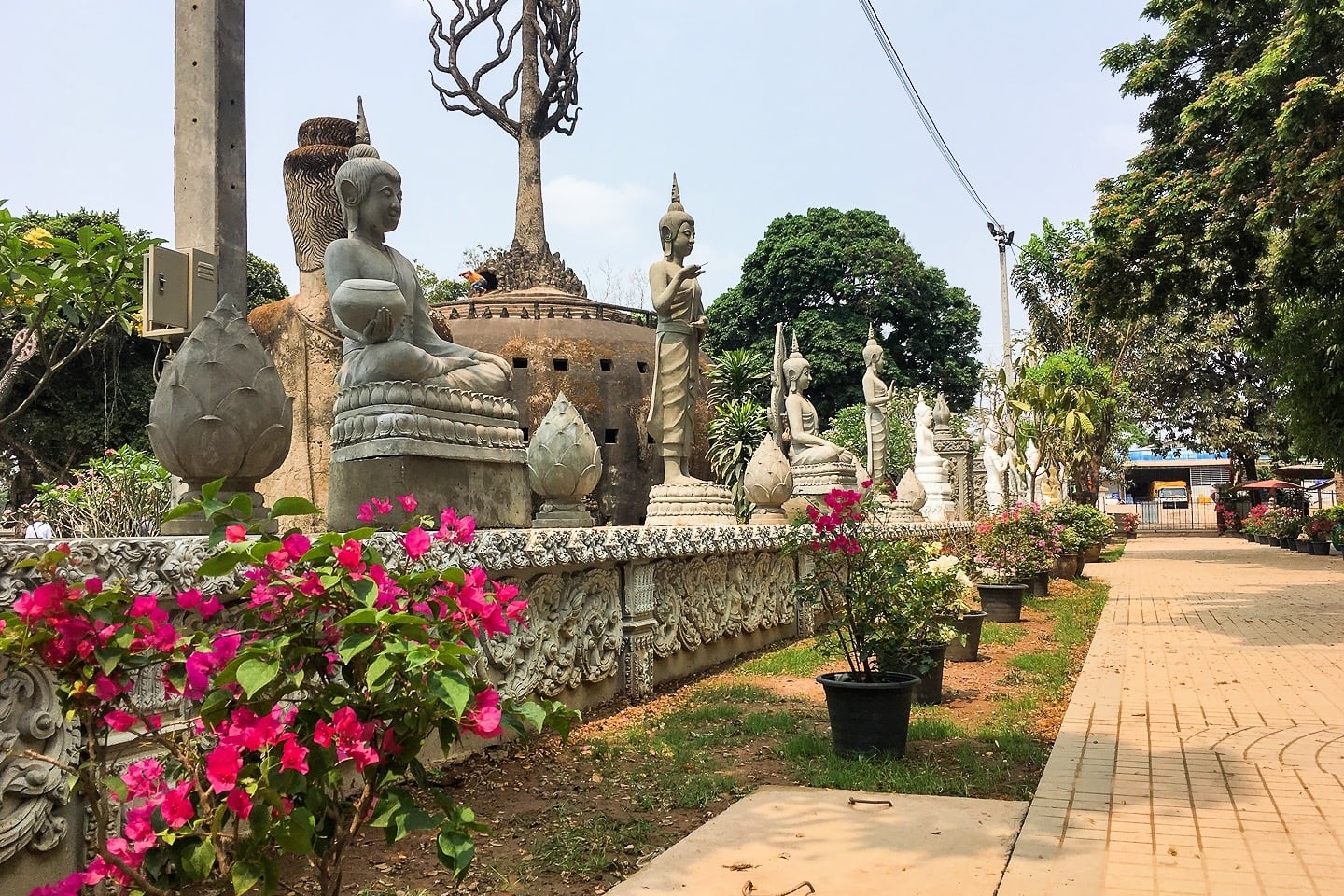
A Sampling of What to Expect
We don’t want to give away too much, but this section should give you an idea of what to expect.
It may not surprise you that the park is full of numerous statues depicting the Buddha. But there are also many other religious symbols and imagery, including characters from Hinduism such as Shiva, Vishnu, and Arjuna.
However, the centerpiece of the park isn’t a Buddha image at all, but a towering behemoth resembling something of a giant pumpkin.
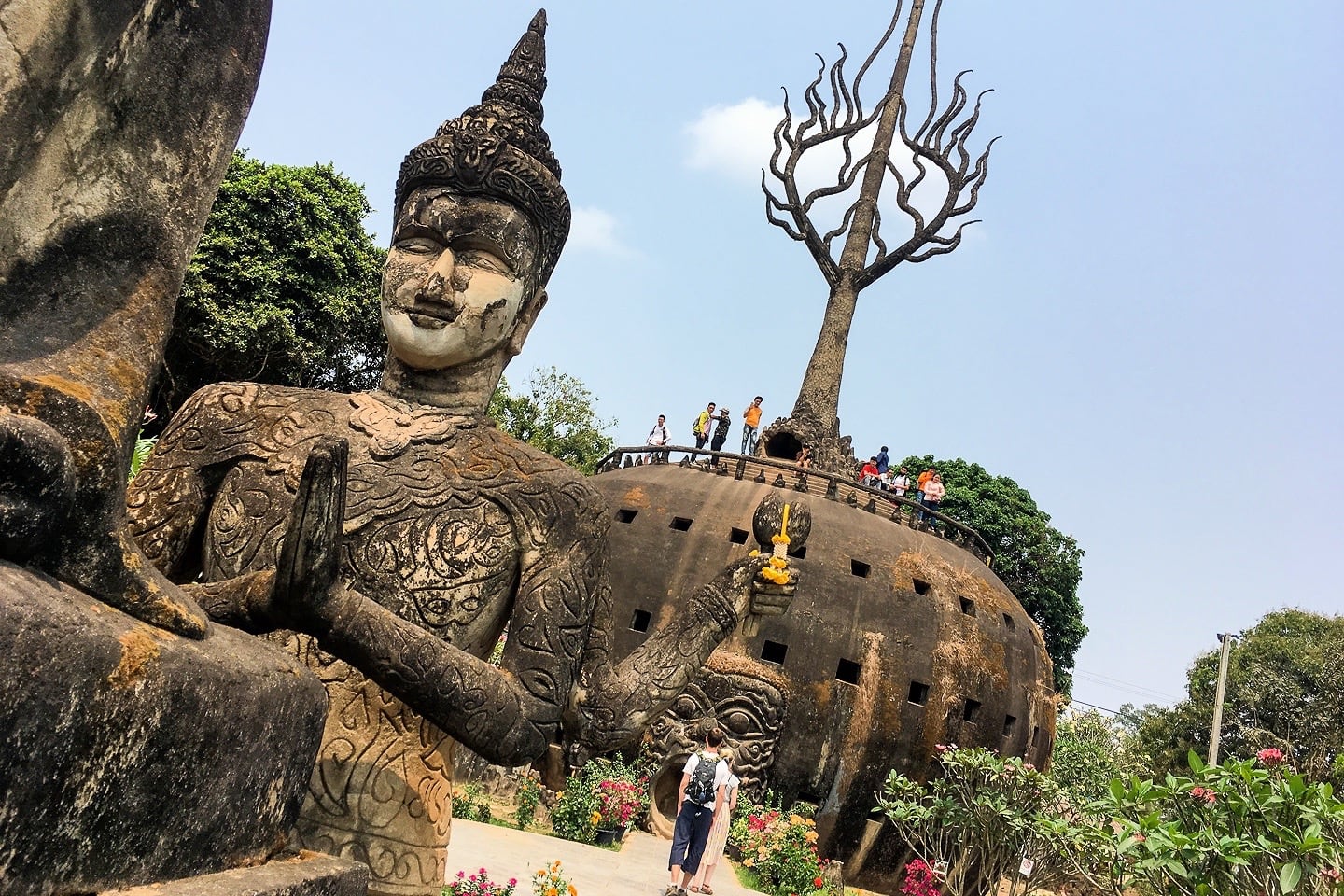
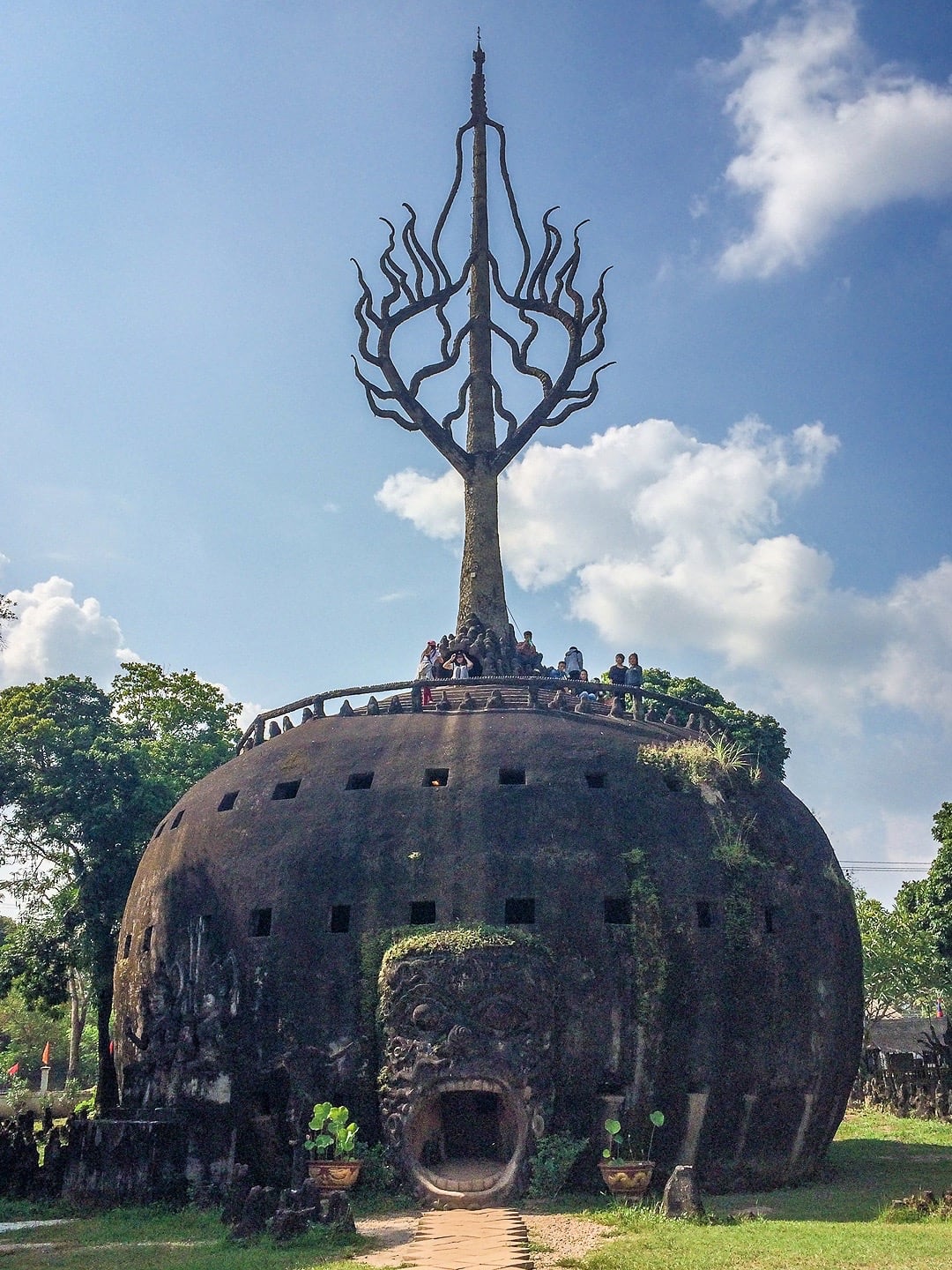
This sculpture has three levels representing Hell, Earth, and Heaven. You can even enter through the giant mouth and see for yourself!
After shimmying and squeezing your way to the top, you will be treated to a sweeping view of the grounds—and the hot midday sun.
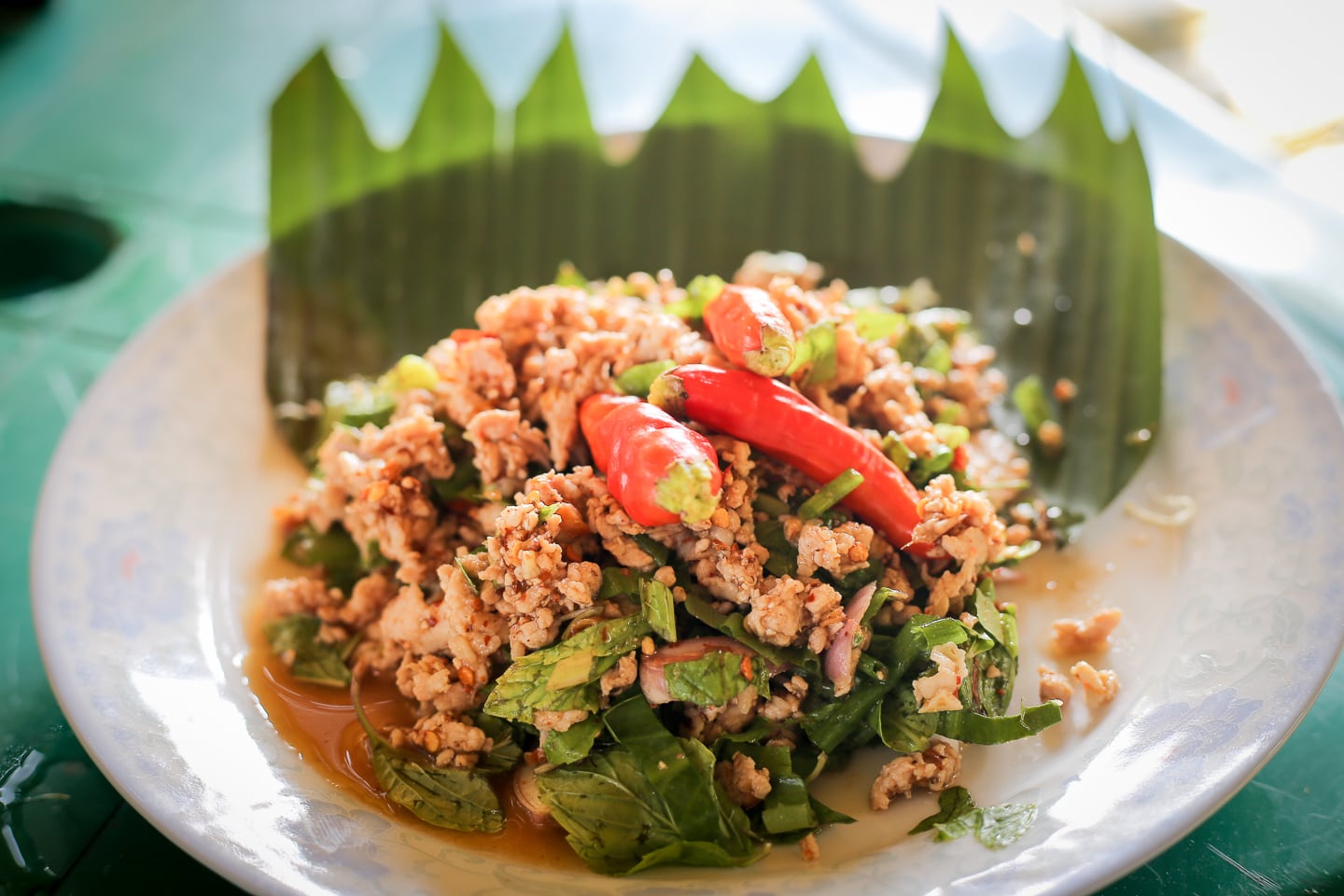
Park Renovations
in 2017, the park made a sizable investment to perform the first major refurbishment and upgrade since the park was constructed in the ’50s and ’60s.
Work was completed in early 2018, including beautiful new walkways, lots of landscape work with countless brightly colored flowers, and…modern restroom facilities to replace what had to have been the park’s original toilets.
More recently, new restaurant facilities and river-facing dining huts have also been added, nearly doubling the size of the park.
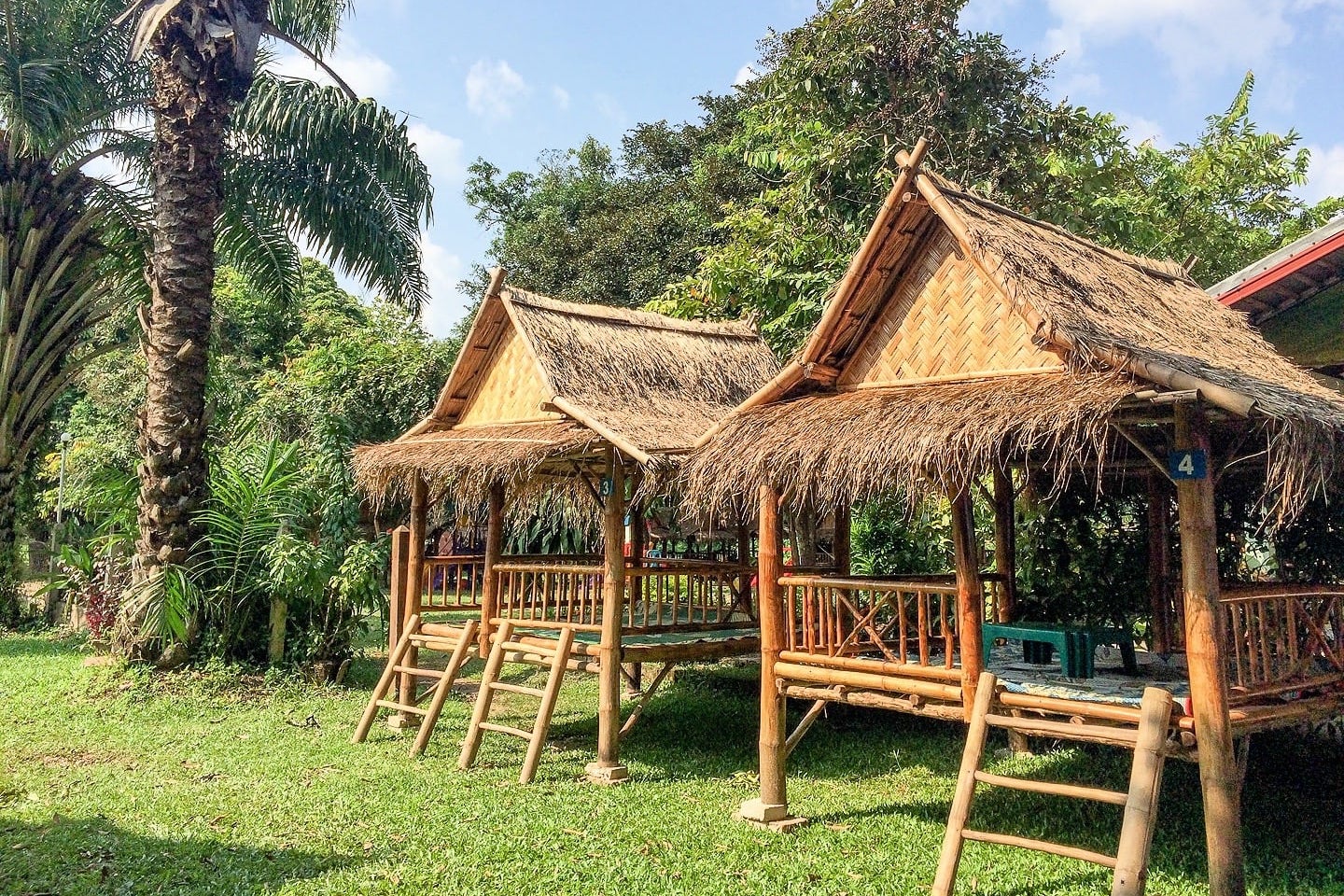
Buddha Park Restaurant
The sculptures are fascinating, but perhaps the biggest surprise of the day was the on-site restaurant toward the rear of the park.
There are relaxing covered bamboo huts for dining and hiding from the sun, and regular old tables for those not feeling the Lao experience.
The pork laab (larb) served at the restaurant was some of the best we’ve had anywhere in Laos. And yes, it’s spicy. That’s the only way to eat it!—but you can always request “bor phet” (no spicy).
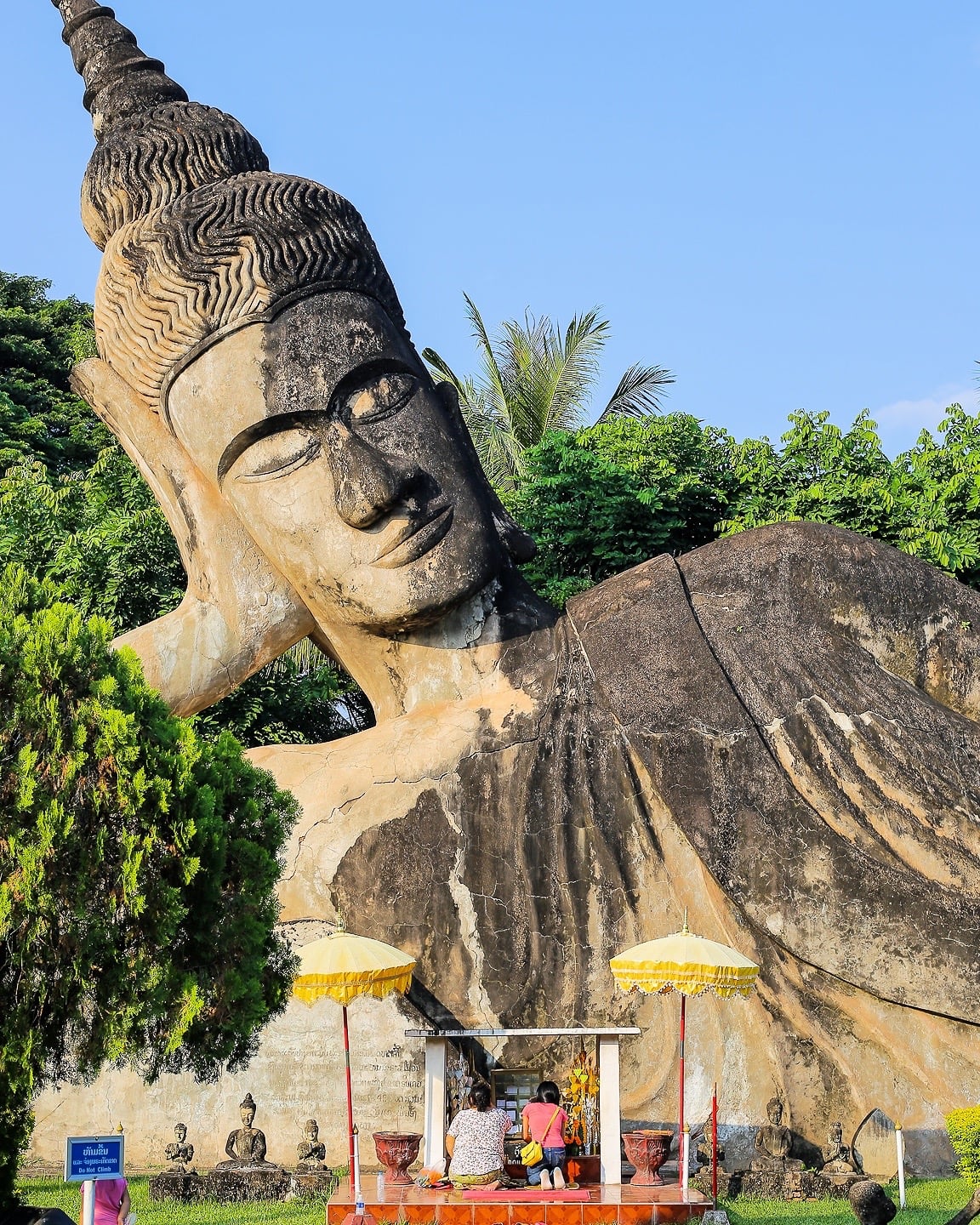
Worth the Visit?
All told, our day out ended up costing the two of us just under US$20 (including roundtrip transport, entry, and a delicious and satisfying meal).
And just as promised, the #14 bus back to town arrived less than 20 minutes after we saw the previous one pass.
Granted, we sat in the bus for half an hour waiting at the Lao-Thai Friendship Bridge parking lot, but it was a small price to pay for cheap, reliable, and air-conditioned transportation back to the city.
Is Buddha Park worth the visit? If you’ve only got a day or two in Vientiane, it’s a big trip to squeeze in. If you’re here for longer, however, Buddha Park is a must.
If you’re not traveling on a backpacker budget, and/or are traveling with others, hiring a taxi through your guesthouse in Vientiane will help cut down some time.
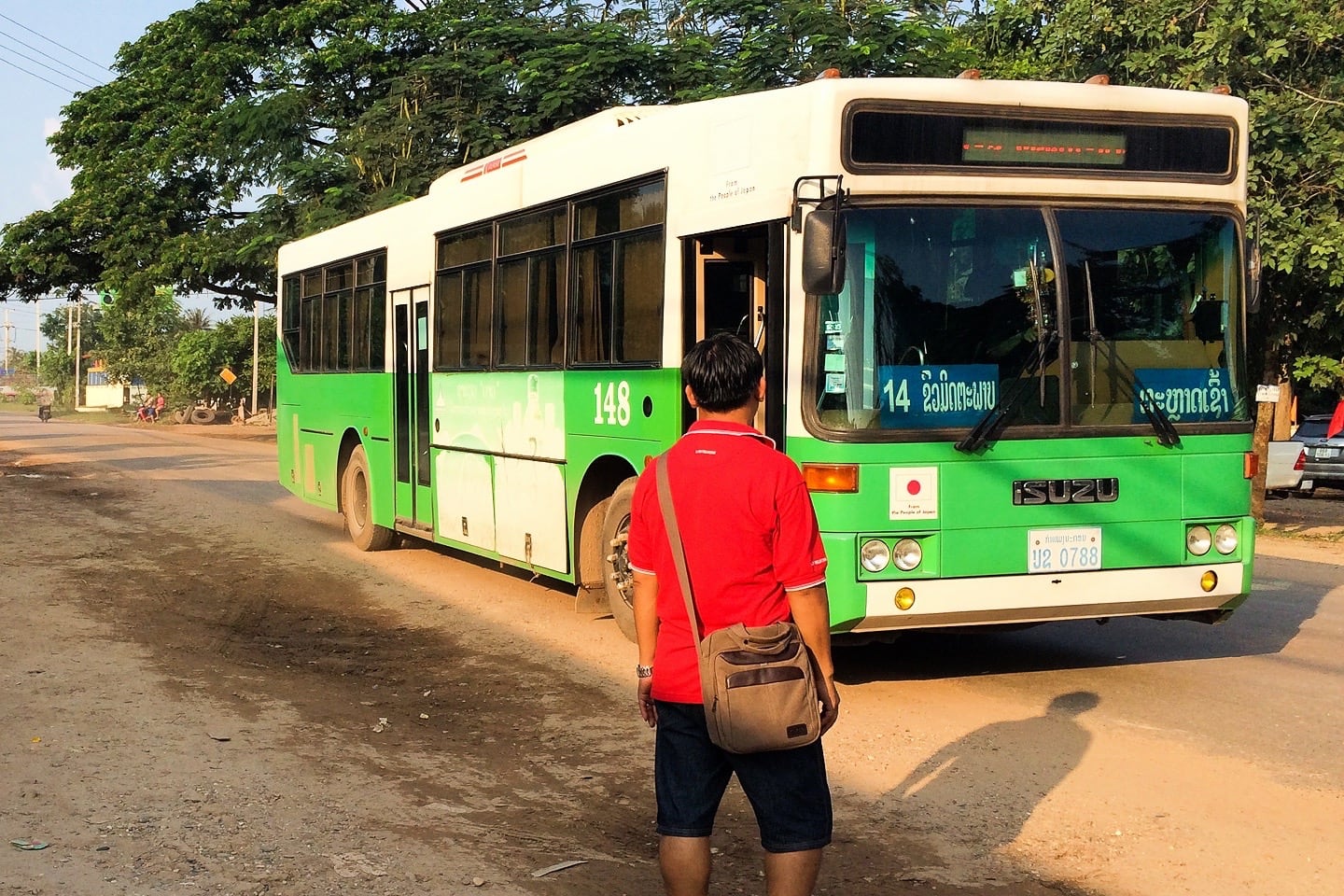
Top Tips for Visiting Buddha Park
Bring sun and rain protection—Expect a chance of hard rain from March through November, and hot and humid conditions year-round. While there are shady spots around the park, the sculptures themselves are largely exposed.
Visit Early!—Buddha Park can get fairly crowded on the weekend beginning around mid-morning. Combine that with the heat and you’ll want to visit as early in the day as possible for the best experience. Alternatively, you can visit towards the end of the day, but keep in mind that temperatures stay toasty well past closing (5pm).
Dress Appropriately—Though often referred to as Wat Xieng Khuan, Buddha Park is not technically a temple. With that said, it is considered by many Buddhists and Hindus to be a holy site, and Buddhist monk sightings are common. Additionally, Laos is a socially conservative country, and most locals dress with modesty in mind. There are currently no dress requirements posted or enforced at the site and shorts are generally acceptable, but you’ll want to dress with casual modesty in mind.
There’s a bit of [optional] “climbing” involved—Don’t be concerned if you have mobility issues. Buddha Park is completely flat and wide concrete paths were added in late 2017 around the entire park. However, if you wish to climb the four levels of the giant pumpkin (totally optional), you’ll need to know ahead of time that some parts require climbing stairs through very tight spaces.
There isn’t a lot in terms of overnight lodging near Buddha Park. See below for our recommendations on where to stay in Vientiane.
Public transport requires patience—Taking the #14 bus from the Central Bus Station is a great way to have a local Laotian experience and save money at the same time. Be mindful that like many other places in Southeast Asia, bus schedules can be flexible and trips can take longer than expected. If you aren’t on a tight schedule, generally taking the bus isn’t an issue.
Onward to Thailand—If you plan on traveling over the border to Thailand (Nong Khai, Udon Thani, etc.) or taking the train to Bangkok following your stay in Vientiane, visiting Buddha Park makes a nice stop en route, as it is located very close to the Thai-Lao Friendship Bridge border crossing.
Nearby Attractions—Inpeng Culture Park (water park); Lao Disabled Women’s Development Centre (local handicrafts, learning); both of the above can be accessed via the #14 Bus, or let your taxi driver know ahead of time that you wish to stop at either place. Both are very close to the Thai-Lao Friendship Bridge.
More Laos Travel Resources
If you plan on traveling around Laos, check out these helpful guides and articles:
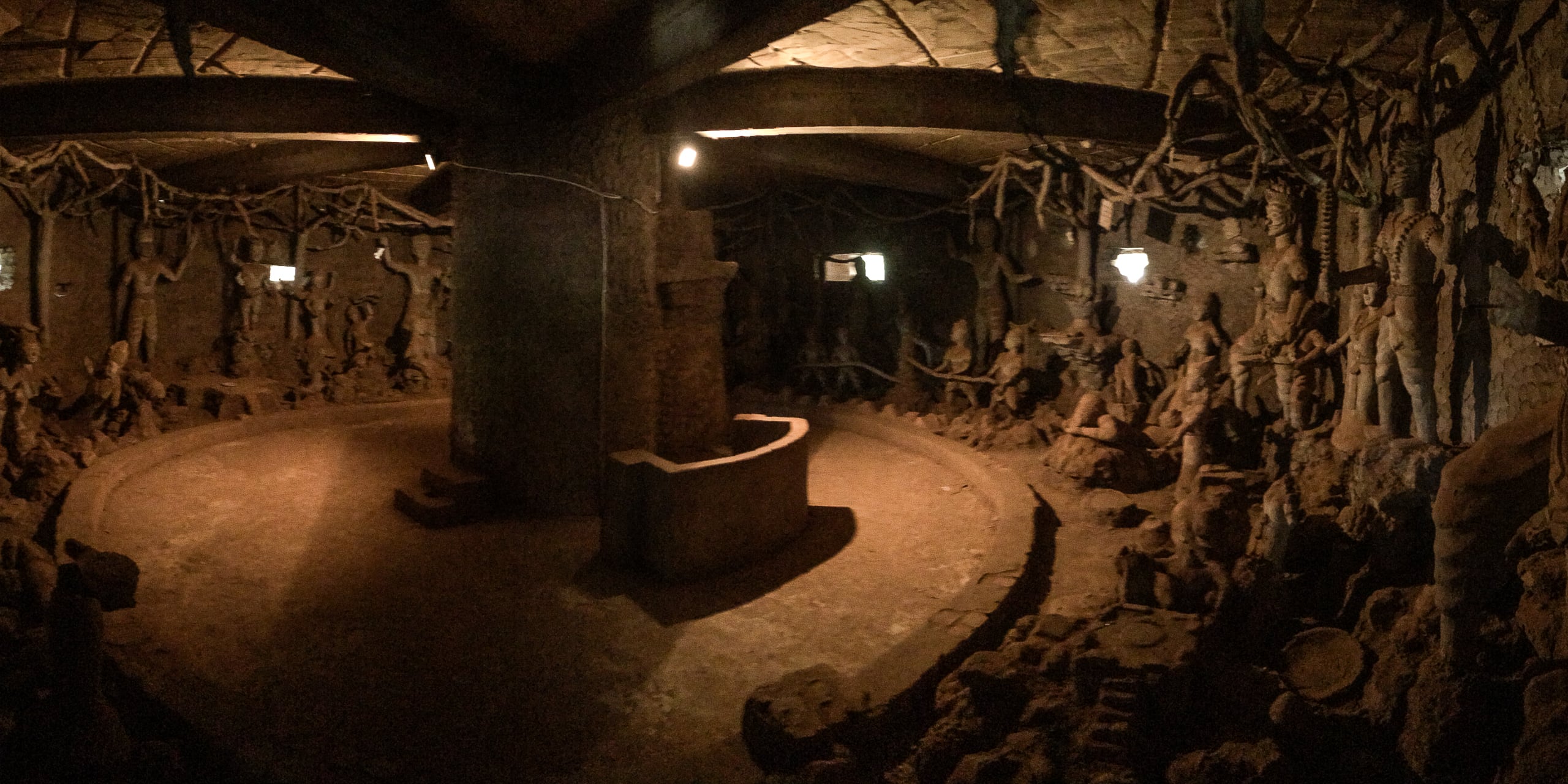
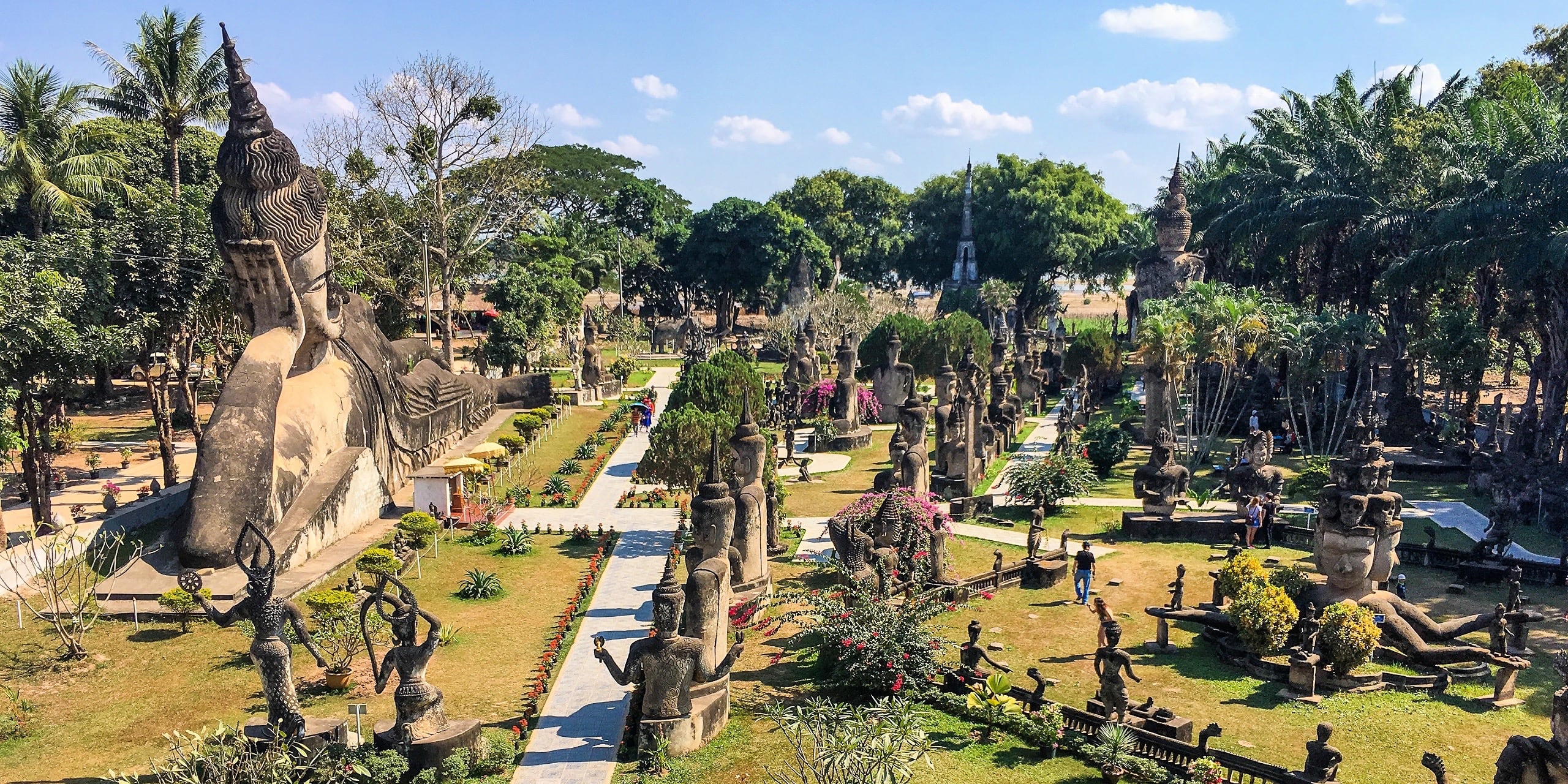
Thanks for the info! Just took the bus in 2024 and it’s now 18,000.
Thanks for the update!
Probably the most comprehensive guide to Buddha Park I have seen, well done!
Awesome! That’s what we like to hear!